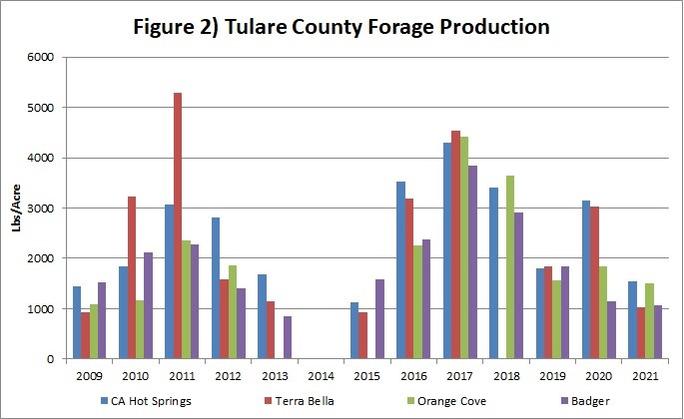Forage Production Measurements
Kern and Tulare County Forage Production Measurement
The forage production measurement project seeks to develop a mean estimate of pounds of forage produced per acre in 6 geographic eco-regions within Kern County, to measure forage production annually, and to make this information available to drought insurance providers as a means of assessing percent forage loss due to drought. This project is replicated in Tulare County. Forage production will be measured annually within 8’ x 8’ exclosures along elevational and precipitation gradients in the six major geographic eco-regions of Kern County. In Tulare County forage production sites were identified by a previous Advisor, Jim Sullins, and were distributed across Tulare County on representative soils. A total of 17 sites are sampled in Kern County and 8 sites are sampled in Tulare County.
This project is an extension of similar projects conducted annually throughout the state on a county level. Vegetation production data is valuable to determine actual forage loss due to drought and is also a highly valuable scientific measurement that can be correlated with other commonly collected vegetation measurements. Long-term forage and vegetation production data are highly valuable due to the rarity of such datasets and the change over time that can be shown through such datasets.
In below average precipitation years, forage production can be compared to mean estimates to determine percent forage loss. Drought insurance providers, mainly the Non-insured Crop Disaster Assistance Program (NAP) program through the USDA Farm Services Agency (FSA), can use this information to determine rancher eligibility for drought insurance payments.
This is a long-term project that provides a service to livestock producers throughout Kern County and Tulare Counties, drought insurance providers, as well as individual participating land owners who will receive valuable forage production data.



Preliminary results (figures 1 and 2)indicate significant variation between and within sites. Variation is attributable to many factors including slope, aspect, variable precipitation patterns across the landscape, elevation, soil type, residual dry matter (RDM) levels, annual weather patterns and more. Results from sampling in 2017 and 2018 highlight the importance of the timing of rainfall. Average rainfall reported by the National Weather Service for the Bakersfield area is about 6 inches. In 2018 about 4.5 inches of rain were received, however, in many parts of Kern County, forage production was average or near average. This is one example of the importance of timing of rainfall. The 2016-17 rainfall year is another good example of the importance of timing of rainfall. Total precipitation was measured at 7.8 inches, but what really made all that rain so effective were two factors. First the rain events were well-distributed; the rain didn’t fall all at once and then quit for a month. Second, the winter wasn’t very cold, so grass growth in the lower elevations was only mildly depressed as a result of low winter temperatures.
What is notable is that it typically requires a half inch of rainfall, received basically in one rain event to germinate the grass. When considering the long-term mean (LT Mean), a half inch of rainfall is not typically received until December in the Bakersfield area. In Tulare County, for the Visalia area a half inch of rain is typically received by October or November. Since December and January tend to be colder months, we can extrapolate and assume that some grass will grow once the grasses have germinated, but most forage production will be in February and March in the lower elevations. As elevation increases the growing season extends with the cooler temperatures and may last into May or June.
The cycle of forage production in annual grasslands is well-known to ranchers as it is a part of daily life and essential to the business operation. Forage production trends can be helpful when planning grazing rotations, livestock purchases and sales, feed and supplement purchases, and more. A key consideration when considering forage production and animal nutritional requirements is planning ahead to leave adequate residual dry matter or RDM for livestock to graze on during what is called the “inadequate green season”. Or the time of the year when there may (or may not) be green grass growing, but not enough forage has grown to meet all of the animals nutritional demands. The inadequate green season typically correlates with fall and winter in Kern and Tulare Counties. Maintaining some RDM through December and January can help sustain livestock until the major forage production period of February and March. It is important to note that once rains start nutrients are rapidly leached from remaining RDM, but the RDM can still provide rumen filler. Further, even after the rains begin to fall, RDM continues to provide protection for the soil and insulate young plants from weather extremes. Planning ahead to leave adequate amounts of RDM into late fall and winter can be a challenge and requires a watchful eye for stocking rate, especially during periods of drought.
